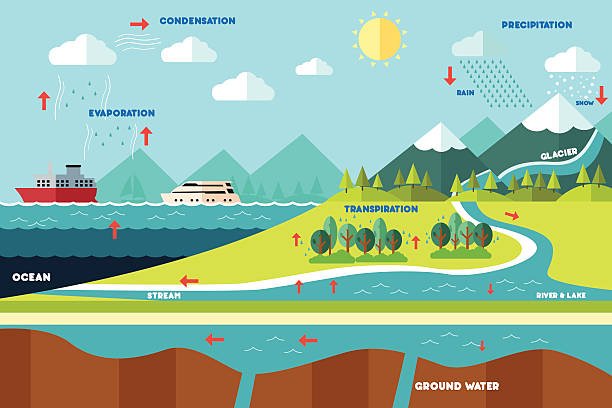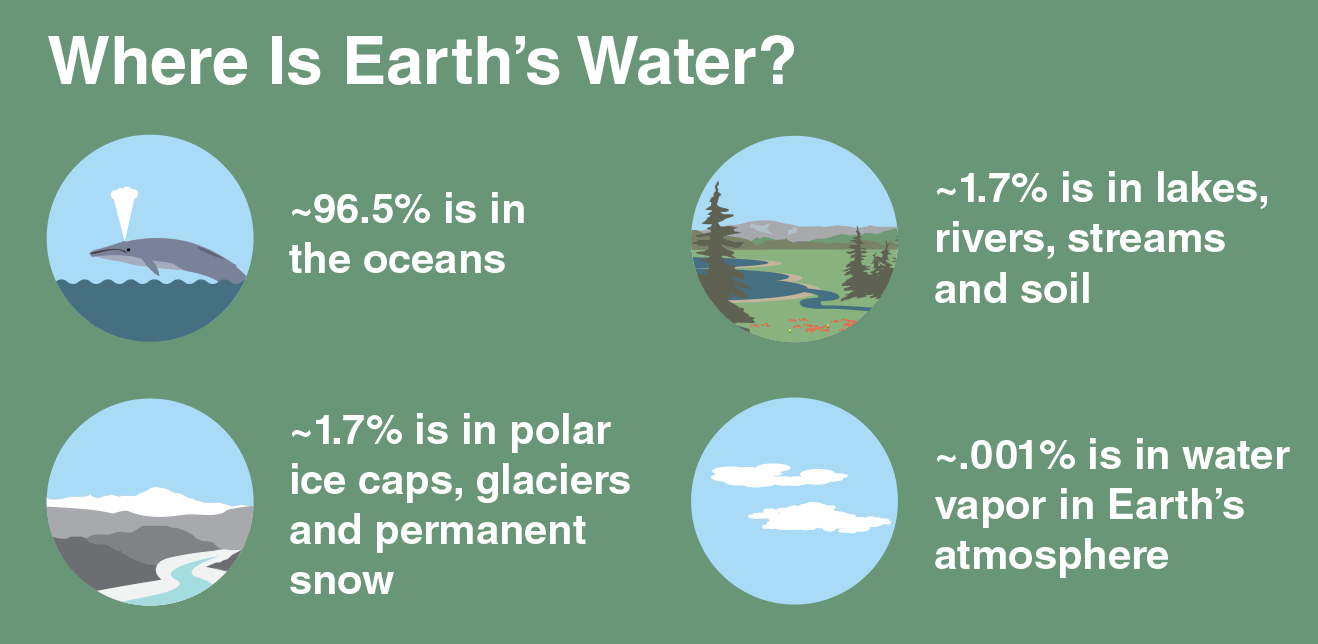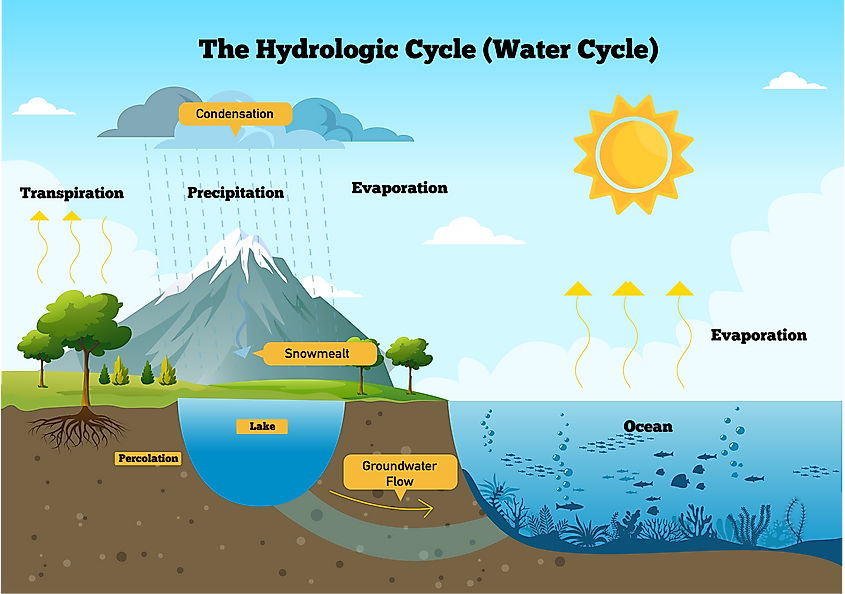On this page we explain how the water cycle supplies us with a continual supply of fresh water.
The water cycle is a vital natural process that replenishes Earth’s supply of fresh water, ensuring the availability of this essential resource for all forms of life. Through a series of interconnected steps—evaporation, condensation, precipitation, and collection—the water cycle continuously recycles water from various sources like oceans, rivers, and lakes back into the atmosphere, only to return it as fresh water through rainfall or snowfall. This cyclical mechanism acts as Earth’s natural filtration system, purifying water and redistributing it across the planet.
Understanding the water cycle’s role in supplying fresh water is critical for both environmental conservation and sustainable resource management. As water evaporates, impurities are left behind, essentially cleansing it before it forms clouds. When these clouds eventually release precipitation, it replenishes groundwater, rivers, and lakes with fresh water. This perpetual recycling ensures a constant and renewable supply of water, which is indispensable for agriculture, industry, and domestic use.
The water or hydrologic cycle is the constant exchange of water in its various forms of liquid, solid (ice and snow), and gas (water vapor) between Earth’s surface, the oceans, and the atmosphere. The hydrologic cycle constantly renews Earth’s supply of freshwater.
7 Steps on How the Water Cycle Supplies Us With a Continual Supply of Fresh Water
The steps below show how is the supply of clean, fresh water on earth renewed by the water cycle.

The water cycle plays an indispensable role in providing a constant supply of fresh water to Earth’s ecosystems. This natural process is a series of interconnected steps that continually recycle water, ensuring its availability for various uses. Here’s a step-by-step breakdown of how the water cycle accomplishes this:
Step 1: Evaporation
Water from Earth’s surfaces—like oceans, lakes, and rivers—evaporates due to heat from the sun. During this phase, water is transformed from a liquid to a vapor, rising into the atmosphere. Importantly, impurities and contaminants are usually left behind, resulting in cleaner, purified water.
Examples
- A puddle drying up on a sunny day.
- Water disappearing from a saucer left outside.
- The decrease of water level in a fish tank due to evaporation.
- A damp cloth becoming dry when hung in the sun.
- Water in a pot turning into steam while boiling.
Step 2: Transpiration
In addition to surface water, plants also contribute to atmospheric water through a process called transpiration. Here, plants release water vapor from their leaves into the air, contributing to the overall humidity and moisture levels in the atmosphere.
Examples
- The moisture on the inside of a car window from plants inside the vehicle.
- Wet soil becoming dry due to plant uptake and transpiration.
- Morning dew disappearing from leaves as they transpire during the day.
- Reduced water level in a vase of fresh flowers.
- Feeling moisture around plants after they’ve been watered.
Step 3: Condensation
As water vapor rises and encounters cooler temperatures in the atmosphere, it condenses into tiny droplets, forming clouds. This is a crucial step as it collects the evaporated and transpired water, preparing it for the next phase.
Examples
- Fogging up of bathroom mirrors after a hot shower.
- Droplets forming on the outside of a cold beverage can.
- Morning dew forming on grass.
- Frost forming on car windows in the winter.
- Clouds forming on a humid day.
Step 4: Cloud Formation and Movement
The condensed water droplets in clouds are moved by air currents, often traveling significant distances. This cloud movement plays a role in distributing water across different geographical locations, contributing to a more equitable distribution of this vital resource.
Examples
- Observing a clear sky becoming cloudy as the day progresses.
- Clouds moving from one part of the sky to another.
Step 5: Precipitation
When the clouds become saturated, they release water in the form of precipitation—rain, snow, sleet, or hail. This fresh water falls onto the Earth’s surface, providing much-needed moisture for plants, animals, and human activities.
Examples
- Rain showers watering your garden.
- Snowflakes accumulating during a winter storm.
- Hailstones during a sudden, severe storm.
- Drizzle making the streets wet.
- Sleet covering the ground in a layer of ice.
Step 6: Collection
Precipitation either gets collected in bodies of water like lakes, rivers, and oceans or seeps into the ground, replenishing groundwater reservoirs. Some of this water is also captured for agricultural, industrial, and domestic use.
Examples
- Rainwater gathering in a pond.
- Melting snow feeding into rivers.
- Rain barrels collecting water for garden use.
- A newly formed puddle after a rainstorm.
- Groundwater levels rising after a period of sustained rain.
Step 7: Runoff
Any excess water flows over the ground surface, known as runoff, and eventually finds its way back into lakes, rivers, and oceans. This water is then ready to be evaporated once again, completing the cycle.
- Water flowing in street gutters after a heavy rain.
- Streams overflowing their banks.
- Melted snow flowing into a lake in spring.
- Water flowing from higher ground to lower ground after a rainstorm.
- Runoff from agricultural fields entering nearby bodies of water.
Examples

Sources
http://www.ces.fau.edu/nasa/resources/water-cycle.php
https://knowitinfo.com/what-is-water-cycle-in-short/
https://www.freedrinkingwater.com/resource-water-cycle-student-guide.htm

